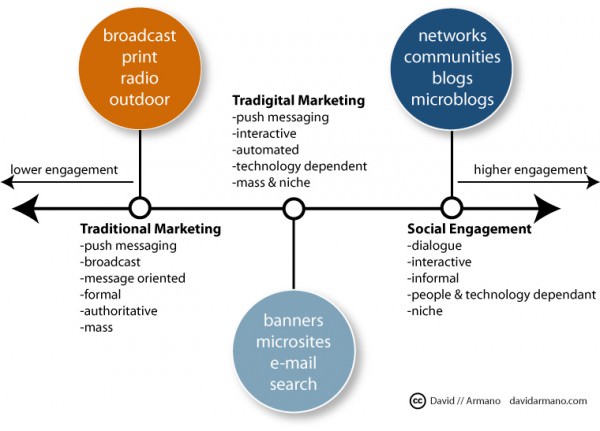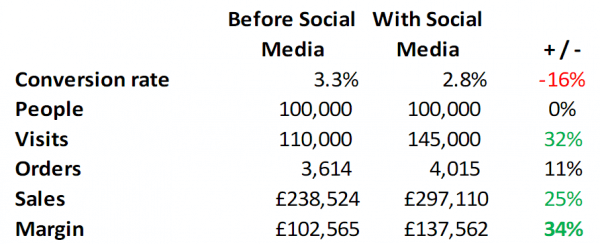Why communications need to change even more to truly engage online audiences
In this post I'm going to take a look at what makes social media different from the media choices that have come before. Only through understanding the differences between social media and more traditional media can we really take advantage of its benefits.
I'm aware that for a lot of readers, I am about to teach my grandmother to suck eggs, I wanted in this series on social media to take it one step at a time, so these ideas follow on from my first post, how to convince your boss about social media. In this post I'll summarise the changes in communications which I think we all need to think through to be more successful in our online marketing.
With the rise of web 2.0 we have effectively entered a new era of media use. Gone is the heyday of one way broadcast communications where so long as you shouted loudly and often enough people bought your product, today marketers must consider the two-way conversation that web 2.0 facilitates.
I think this diagram from David Armano is a great way to summarise the changes that have taken place:

Source: http://darmano.typepad.com/.a/6a00d8341bfa9853ef0115709cc666970b-800wi
Web 2.0 isn’t really a change in technology in itself, it’s more a change in the way in which we are using web based technologies. As Clay Shirky says “A revolution doesn’t happen when society adopts new tools. It happens when society adopts new behaviours”.
Websites have gone from online brochures to interactive, engaging forums where customers can chat with the company and each other as well as rating content, “liking” pages and generally occupy a seat that much closer to the driver. User generated content is increasingly fuelling SEO and becoming an essential part of an effective brand.
According to Ofcom’s 2010 report, social networking now accounts for 23% of all the time spent online in the UK. BizReport found that about 2 million UK workers spend at least an hour a day on social networks while at work with 55% of the UK’s workforce accessing social media at work.
As we see even our grandparents generation increasingly comfortable with online spaces such as Facebook we find that indeed the old ways of marketing are dying.
Mark Stuart, in his excellent CIM Shape the Agenda paper What hasn’t happened yet. The shape of digital to come (March 2010) states that
“People tend to stick to the same five or six sites that they know and trust. Within these small ‘villages’ the marketer is replacing the shopkeeper – offering the customer things they might not spot themselves….
With people self-selecting the villages they inhabit, marketers need to ensure they have a presence in those places, rather than trying to drive customers to their own sites, which is increasingly a much harder proposition.”
Stuart reflects that brands are no longer driving traffic to microsites and big corporate websites, instead they are going to the places where their potential customers hang out – Facebook, YouTube, Twitter – and building a presence there. But the presence they build is very different to the websites of old, it is a presence that facilitates conversation and experience rather than broadcast advertising.
Seth Godin dismisses these traditional marketing methods as "interruption marketing". You can see from the graphic above that traditional, one-way broadcast messages generally fail to engage to the same degree as the less formal, interactive style of social media. The further you move to the right of the spectrum, the more that the formal one-way message becomes an informal two-way dialogue.
But social media isn’t simply about learning how to use a new set of marketing tools. Its an entirely new language. Companies make huge mistakes when they jump into a social media channel and start broadcasting messages without first listening to the language and learning the culture. Jeremiah Owyang, writing at Web-Strategist.com says
“Those who ignore the party/conversation/network when they are content and decide to drop in when they need the network may not succeed. It’s pretty easy to spot those that are just joining the network purely to take – not to give. Therefore, be part of the party/conversation/network before you need anything from anyone.”
The web, and social media in particular has driven us from formal communications style and tone to something far less formal. Something that sounds far more like a normal conversation.
As well as social media being more about conversation than broadcast, it incorporates the phenomenon of C2C interaction. Seth Godin writes “Conversations among the members of your marketplace happen whether you like it or not. Good marketing encourages the right sort of conversations.”
Customer experience management specialists Tealeaf found that 59% of UK shoppers are influenced by availability of product ratings (a common C2C communication tool). And 75% of respondents to a Tealeaf survey said their choice of retailer was influenced by what they read on social media sites.
Take a look at this example of the effect of social media on sales and margin (this was taken from Matthew Tod’s How to Measure Digital Success (APA Digital Breakfast May 2010)

This paradigm shift to less formal, interactive conversation needs to take place in more than just your use of marketing tools. Organisations that thrive in the new marketplace are those that embrace new methods of working across the workforce. Karie Willyerd & Jeanne C. Meister, HarvardBusiness.org say:
“More companies are discovering that an über-connected workplace is not just about implementing a new set of tools — it is also about embracing a cultural shift to create an open environment where employees are encouraged to share, innovate and collaborate virtually.”
Soren Gordhamer, writing in Mashable earlier this year, cited research by Towers Watson, the global professional services firm which found that companies with high employee engagement had a 19% increase in operating income and almost a 28% growth in earnings per share. Conversely, companies with low levels of engagement saw operating income drop more than 32% and earnings per share decline over 11%.
He went on to define five new paradigms for a socially engaged company. I’ve summarised these below:
| Dimension |
Old Paradigm |
New Paradigm |
| Culture |
Force people to do what you want |
Give people what you want them to offer |
| Mindset |
Just put your body in the room |
Show up with a creative, open mindset. |
| Group wisdom |
All wisdom exists at the top |
Listen and make space for various voices |
| Environment |
Do what is normal |
Approach space creatively to serve the purpose |
| Vision |
Work to get a paycheck |
Make your work about something bigger |
Adapted from http://mashable.com/2011/01/13/socially-engaged-company/
So, it's certainly no longer "business as usual", but how much has your organisation changed?
How has your organisation changed as a result of social media?
What changes have you observed in your company’s marketing communications in the last 5 years?
What is your company still struggling with in relation to embracing the new social media paradigm?
What crimes in social media have you witnessed?






